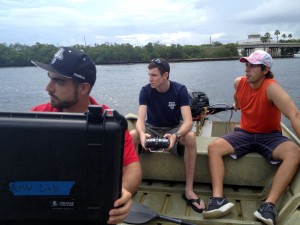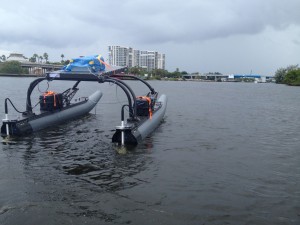FAU Students Building Robot Boat To Conquer The World

John O'Connor / StateImpact Florida
Ivan Bertaska, Anderson Lebadd and Edoardo Sarda run their robotic boat through the motions on the Intracoastal Waterway near Dania Beach.
On the Intracoastal Waterway near Dania Beach, Ivan Bertaska was getting ready to captain his vessel.
Bertaska wants to check the boat’s capabilities by having it speed up and slow down as it carves a wavy wake across the Intracoastal.
“The wave pattern actually gives me a good range of velocities,” he said, “so at first we go about two knots and then we get to the top corners where we’re making sharp turns we’re going about one knot. So I get a good operational range of the vehicle.
“We get a lot of funny looks from boaters.”
Funny looks because Bertaska and a team of other engineers are building a boat that can drive itself.
The team is from Florida Atlantic University and Villanova University in Philadelphia. It includes FAU student Edoardo Sarda and Villanova student Anderson Lebbad. They’re traveling to Singapore in October for the Maritime RobotX Challenge.
And they’re one of just three teams from the United States chosen for the competition.
The boat will have to use sonar, light and color sensors to perform a series of tasks, including navigating an obstacle course.
This is the first time this competition is happening.
Teams are given the platform of a boat and they must design scanners and sensors that allow the boat to perform five tasks on its own with no humans on board.
The first is a short, slalom like sprint.
Next, the boat must find its way from a start gate to an end gate while navigating an obstacle course in between.
Then the boat must identify one of several marina slips identified by a shape, find it and then stop in marina slip.

John O'Connor / StateImpact Florida
Marine Advanced Research donated a WAM-V unmanned boat platform to each team. From there, they have to design sensors and programming to perform five tasks.
Another task requires the boat to find a light tower with a a different colored light pattern on three sides. The boat must report the sequence and frequency of flashing light pattern.
Finally, the boat must locate and report which underwater object is sending out a signal.
Bertaska and Sarda feel good that the boat will be up to the challenge.
“We’ve made significant progress,” Bertaska said. “I think that we’re going to be really, really prepared for it.”
“There’s lots of work left to do, but there’s also time,” Sarda said. “So, we’re optimistic”
They’re optimistic, but unfortunately there’s no more time on this recent day – a storm is coming.
Bertaska is worried about my recording equipment getting drenched.
“Uh guys it’s raining down there so we should probably think about heading in,” he said.
“Yeah, we’re going to get wet,” Sarda responded.
Back to the workshop, the rest of the team is testing the scanning laser and fine-tuning the computer programs that make the on-board decisions.
Karl von Ellenrieder is supervising the team. He’s a Florida Atlantic University ocean and mechanical engineering professor. He said the students have a month to pull everything together before they head to Singapore.
“We basically have to put it on the water and test it like crazy to make sure that everything works like we expect it to,” he said
Von Ellenrieder said they’ll have to beat teams from all over the world.
“It’s a truly international competition,” he said. “South Korea and Japan are powerhouses in robotics and so it’s going to be very challenging to compete against them I think.”
Von Ellenrieder said competitions like RobotX give his students a real world education.
“Mechanical engineers end up learning a little bit about electronics, a little bit about computer science. Ocean engineers the same,” he said. “They get a really nice, interdisciplinary, kind of, experience that really broadens their background.”
They’re also getting a lesson in economics. The team won a $25,000 dollar grant from the U.S. Office of Naval Research. But they still need to raise about $50,000 more to pay for travel costs for the entire team.
The team has set up a website to raise money for the trip and update their progress.
